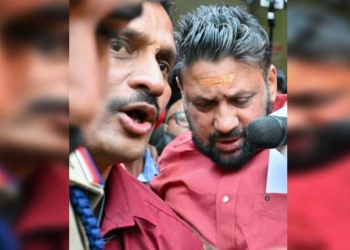New Delhi: Nestled in the intimidating Himalayas, the valley of Kashmir, as much as it is a picture of heavenly environs with its exquisite abundance of nature, muffles the murmurs, cries, and even silence of many. Beyond the deafening sounds of conflict of three decades is the muted voice of those driven to do the forbidden — suicide.
There have been frequent news of youth resorting to suicide in Kashmir. Hanging oneself to death and jumping into a river are the commonly reported ways of committing suicide. However, a number of factors lead one to this extremity.
Suicidal thoughts and behaviour may be determined by several individual and social factors. The frequency suicides may arguably reflect a social disorder more than an individual’s disordered mental state. As indicated by Emile Durkheim, the father of Sociology, suicide can be a result of social change.
Continued political instability in the valley and the shadow of militancy have an imprint on the economic and social fabric of the region; stress factors thus emerging affect daily lives of the common man.
Degraded quality of education, spiraling unemployment, and increasing health-related concerns are worsening woes in Kashmir.
As of 2020, as per the National Human Rights Commission, suicide has claimed maximum lives in Kashmir after militancy. The rate of suicide is said to have increased by 26 times, from 0.5 per 100,000 before insurgency broke out, to 13 per 100,000.
A study by Medecins Sans Frontieres (MSF, aka Doctors Without Borders) reveals an alarming 400 per cent increase in the suicide rate.
In 2021, 586 people attempted suicide in Kashmir. The figure stood at 20 in Jammu.
Central Kashmir’s Budgam district and north Kashmir’s Baramulla reported 73 cases of suicide each. This is followed by south Kashmir’s Anantnag which reported 67 cases. Srinagar reported 51 cases of attempt of suicide.
In 2021, 41 cases of abetment to suicide were registered in Kashmir against 35 in 2020.
In 2020, the year of the pandemic, over 450 cases of suicide were reported—the highest in a decade.
In 2017, there were 287 suicides in Jammu & Kashmir. The figure increased to 330 in 2018.
2019 saw a marginal drop in numbers with 284 reported cases. The (erstwhile) state reported a suicide rate of 10.3 per 100,000 people that year. The national average is 10.2.
From 2010 to 2020, the valley witnessed 3,024 cases of suicide.
Dr Mudassir Hassan Pandith, a Kashmir-based Clinical Psychologist, in conversation with IANS, said that “Suicides always happened. But now with easy access to social media, incidents are highlighted way much more.”
He points out a pertinent aspect that contributes to the escalating numbers of suicide in the valley.
“A youth could die from (drug) overdoes and it may appear as suicide as the addiction might be undiagnosed,” he said.
Surface-level reasons such as negative environment at home, or strained interpersonal relationships (and even break-up), financial set-back, failure in examination for youth, etc may be an impetus for committing suicide, but “Suicidal tendency is a personality-based tendency,” he explained, adding that “it is impulsive behaviour.”
However, “before committing suicide, a person leaves behind several hints,” he said, meaning that an impending suicide is but foreseeable.
However, “Society and people are not as connected as they used to be,” he said, adding that misinformation and disinformation significantly impact common perceptions as people are isolated and confined to their own immediate concerns.
This also indicates the shift from common social interactions to relying on social media updates for one’s awareness of their surroundings.
General reasons include political uncertainty and economic downslide but specific reasons pertain to family and household.
Increasing instances of marital discord, incompatibility, domestic violence, broken homes and dysfunctional families have caused a spike in divorces in Kashmir, which is looked down upon.
Many who choose to remain in a socially acceptable but detrimental situation, resort to suicide. Most women who committed suicide took the extreme step due to “marriage related issues.”
The aspects of gender come into play as the rate of males committing suicide in on the rise in Kashmir. While addiction may arguably be a reason, as discussed above, social reasons cannot be overlooked. As bread-winners of the family in constrained economic situation, suicidal thoughts are said to be instigated in men.
In 2021, the overall male-to-female ratio of suicide victims in Kashmir stood at 73:27. In 2020, the figure was 71:29.
Dr Pandith encapsulates that a common man’s standard response to stress and his method of coping is: “Excessive smoking, then drugs, and then drugs turn the course (of the individual).”
The deeply entrenched stigma surrounding social aspects of a mental health condition or illness keeps an individual or a family from seeking help in time, thereby compounding a critical situation.
It is pointed out that among Muslim societies, Kashmir records very high numbers of suicide.
The Islamic religion is a major deterrent for a believer to keep them from committing suicide, as those who are not to be allowed the due last rites. Dr Pandith explained: “Islam forbids suicide. Some say that if only Islam did not prohibit suicide, they would have committed it.”
Societal pressures are a major factor that directly or indirectly drive one to the point of suicide. Clearly, addressing this concern has to begin at the collective level of society.
Dr Pandith spoke of the need for concerted effort by way of an elaborate long-term initiative that must begin with young school children.
Considering that suicidal tendencies could be “personality-based,” he suggested that institutions should consciously invest in students and “understand their personalities under professional supervision.”
Age-appropriate approaches must be extended to college students to “understand their personalities and educate and train them suitably to not fall for self-destructive tendencies.”
Dr Pandith maintains that the quality of “education has deteriorated and has narrowed down” in Kashmir, and that “Understanding, research etc, are all mobile-based not book-based.”
“So efforts have to be made at the level of young individuals,” he insisted.
About addressing the matter at the collective level, Dr Pandith is of the opinion that the clergy have a role to play in strengthening social values. “Maulanas must be prepared to address social concerns of this nature, and broaden perspectives about society and culture.”
In a rapidly changing society driven by prompt communication, Dr Pandith acknowledged the role of mass media in spreading awareness about the impersonal nature of a mental health condition and the ability to identify and the need to seek professional help when required, thereby also shattering the stigma shrouding mental illnesses.
(IANS)














